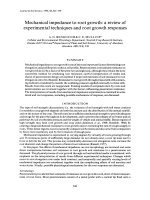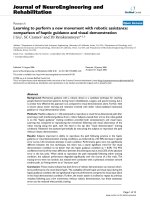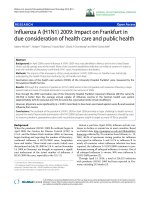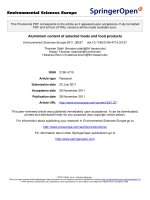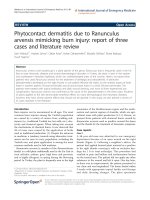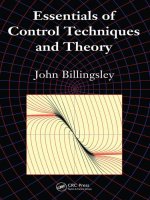Essentials of control techniques and Keyword Stats_11 ppt
Bạn đang xem bản rút gọn của tài liệu. Xem và tải ngay bản đầy đủ của tài liệu tại đây (1.35 MB, 27 trang )
Design Methods for Computer Control ◾ 283
12
2
12
21
1
2
21
1
4
+
+
=
+
−
+
+
−
+
=
+
w
w
z
z
z
z
()
()
()
()
()
τ
τ
τ
zz
z
z
z
+
++−
=
−
−
()
()()
τ−
ττ
4
22 22
41 39
22 18
when we substitute the value of 0.1 for τ.
A zero at z = 0.951 and a pole at z = 0.818 are added to the root locus diagram,
with a result illustrated in the plots shown in Figure 20.5. Stable control is now
possible, but the settling time is not short. How can we tell?
In the negative-real half of the s-plane, the real part of s defines an exponential
decay rate while the imaginary part defines a frequency. A complex pair of roots can
be viewed as the roots of a quadratic
ss
2
00
2
20++=ζω ω
where ω
0
is the undamped natural frequency and ζ is the damping factor.
Unit
circle
Figure 20.5 Root locus with compensator. (Screen grab of www.esscont.com/20/
rootzcomp.htm)
91239.indb 283 10/12/09 1:48:10 PM
284 ◾ Essentials of Control Techniques and Theory
e damping factor dictates the shape of the step response while the natural
frequency determines its speed. A collection of responses for varying values of ζ are
shown in Figure 20.6.
Now constant values of ω
0
will correspond to points on circles around the ori-
gin of the s-plane. Constant values of damping factor will lie on lines through the
origin at an angle cos
–1
ζ to the negative real axis. is is shown in Figure 20.7.
A value of ζ = 0.7 gives a response of acceptable appearance. is is a very
popular choice of damping factor, apparently for no more complicated reason than
that the poles lie on lines drawn at 45º through the s-plane origin! e natural
ζ=0
Time
ζ=.4
ζ=.7
ζ=1
Figure 20.6 Responses for a variety of damping factors.
2
0
0
0.2
0.2
0.38
0.38
0.56
0.56
0.71
0.71
0.83
0.83
0.92
0.92
0.98
0.98
1
1.75
1.5
1.25
1
0.75
0.25
0.5
Figure 20.7 Lines of constant damping factor and of constant undamped natural
frequency.
91239.indb 284 10/12/09 1:48:12 PM
Design Methods for Computer Control ◾ 285
frequency, the frequency at which the system would oscillate if the damping were
removed, is now represented by the distance from the origin.
To translate these yardsticks into the discrete time world, we must use the rela-
tionship z = e
sτ
. Damping factors and natural frequencies are mapped into the
interior of the unit circle as shown in Figure 20.8.
Now we are in a position to judge how effective a compensator can be by exam-
ining its root locus. We can clearly do better than the gentle phase advance we
started with. We could perhaps mix the feedback signal with a pseudo-derivative
formed by taking the signal and subtracting its previous value
uayn bynyn=+−−() (()( ))1
i.e.,
UabbzY=+(( )/).−
is gives a pole at the origin and a zero that we can place anywhere on the seg-
ment of the real axis joining the origin to z = 1. A root locus for the case where the
zero is at z = 0.5 is shown in Figure 20.9. In software it would be implemented for
some chosen value of gain by
u=–k*(2*y–yold);
yold=y;
Would the performance of the system have been more easily deduced from
its s-plane transfer function, using the approximate equivalence of s to w? If we
Figure 20.8 z-plane loci for constant ζ and for constant ω
0
.
91239.indb 285 10/12/09 1:48:13 PM
286 ◾ Essentials of Control Techniques and Theory
substitute w for s, and then replace w by 2(z – 1)/τ(z + 1) we will have a system
transfer function with three zeros at z = 1 and three poles at z = –1. Adding in the
“differencer” removes one of the poles, but adds another pole at z = 0. e result
bears little resemblance to the system we must actually control. e w-transform
may enable us to devise filters, but could be misleading for modeling a system.
On the other hand, the z-transform transfer function can be translated exactly
into the w-plane by substituting (2 + wτ)/(2 – wτ) for z. Now a w-plane compensa-
tor can be tried out, plotting the resulting root locus in the w-plane. e stability
criterion is the familiar one of requiring all the poles to have negative real parts.
Q 20.5.1
Represent the motor position problem by a transfer function in w; sketch its root
locus for proportional feedback. What is the effect of a compensator with transfer
function (1 + w)? Can such a compensator be realized?
Making the substitution z = (2 + wτ)/(2 – wτ) in Equation 20.2 gives us a trans-
fer function (1 – wτ/2)/w
2
for the DAC and motor combination. is has two poles
at the origin and a zero at w = 20. e root locus illustrated in Figure 20.10 shows
that feedback alone will not suffice.
e compensator (1 + w) adds a second zero at w = –1. Do the twin poles now
split, one moving to the left and the other to the right along the real axis to each
zero?
Not a bit.
e transfer function has an extra negative sign, seen when it is rewritten
as –(wτ/2 – 1)/w
2
, so the valid real-axis part of the locus lies outside the zeros,
Unit circle
Figure 20.9 Root locus with “differencing” controller, a zero at 0.5 and pole at
the origin.
91239.indb 286 10/12/09 1:48:15 PM
Design Methods for Computer Control ◾ 287
not between them. e poles split North and South, following a circular path to
recombine on the negative real axis. One pole now approaches the zero at w = –1,
while the other makes off to minus infinity, reappearing at plus infinity to return
along the real axis to the second zero. Figure 20.11 shows the result.
e compensator is not hard to realize. Another substitution, this time
replacing (1 + w) by (1 + 2(z – 1)/0.1(z + 1), gives us the transfer function
k
z
z
21 19
1
−
+
which can be rewritten as
k
z
z
21 19
1
1
1
−
+
−
−
w real
w imaginary
20
2 poles
Zero
Figure 20.10 w-plane root locus for uncompensated feedback.
w real
w imaginary
20
2 poles at 0
Zero
Zero
at –1
Figure 20.11 w-plane root locus with (1 + w) compensation.
91239.indb 287 10/12/09 1:48:17 PM
288 ◾ Essentials of Control Techniques and Theory
So we have
UzUk zY=+−−
−−11
21 19()
e code to calculate this is
u=–uold+k*(21*y–19*yold);
uold=u;
yold=y;
When preceded by an input statement to read y from the sampler and followed
by a command to output u to the DAC, this will construct the compensator in
question. On its own the compensator looks marginally unstable, but when incor-
porated in the loop it should be able to perform as predicted.
It appears deceptively simple to place a few compensator poles and zeros to
achieve a desired response. ere must be further objectives and criteria involved in
designing a control system. Indeed there are. Our problems are just beginning.
But first let us look at a final root locus. In Sections 18.7 and 18.8 a controller
was devised to give a dead-beat response. Expression 18.18 shows that it has a pole
at a negative real value of z, at z = –0.75, giving an even more dramatic modifica-
tion of the root locus. e zero is now at z = 0.6, and the result is illustrated in
Figure 20.12. Note that all the roots come together at the origin.
Unit circle
Figure 20.12 Root locus giving a dead-beat system.
91239.indb 288 10/12/09 1:48:18 PM
289
21Chapter
Errors and Noise
21.1 Disturbances
Until now, our systems have included inputs, states, and outputs. Our disturbances
have been represented by initial conditions, and we have assumed that the goal of
the controller is to bring the error to zero in the absence of any other input. is is
an oversimplification, since the objective of many controllers is to combat distur-
bances that afflict the system.
In the water-heater experiment of Chapter 5, we saw the PID controller pro-
posed as a way to correct for a standing error. It is a useful device that industry
applies to a variety of problems. With the derivative (or phase advance) action of
the “D” term added to the proportional “P” term, many second-order systems can
be brought to stability. e integral “I” term means that the drive will continue to
increase until the error has been driven to zero—or until the limit of maximum
drive is reached.
Many principles of controller design have arisen from the needs of gunnery. A
controller containing one integration can reduce to zero the aiming error with a
stationary target, but will have a tracking error proportional to the target’s velocity.
With a second integrator we can track a target without error at constant velocity,
but the aim will be thrown off by acceleration. Each additional integrator raises
the order of the polynomial that can be followed, but introduces a more prolonged
transient behavior in acquiring the target. Fortunately most industrial problems
can be solved with no more than a single integration.
Integral control is a method open to a simple analog controller. When the con-
troller is digital, many more sophisticated techniques are available. e controller
can be “aware” of a change of demand, and integral correction can pause until
the response has settled. e error can then be integrated over a finite, predefined
91239.indb 289 10/12/09 1:48:19 PM
290 ◾ Essentials of Control Techniques and Theory
interval of time, to find the average correction needed and this can be applied as
a step change of input. After a delay to allow the transient to pass, the integration
can be repeated. In this way, there is a hope of achieving dead-beat correction of
the offset, instead of the slow exponential decay resulting from continuous integral
feedback.
Now we must investigate the various forms of disturbance in a more general
way with the aid of some block diagrams as shown in Figure 21.1.
N1: e command input is subject to noise of various forms, from quantiza-
tion of a numeric command to tolerances in encoding a control lever. is error is
outside the loop and therefore nothing can be done about it. e target will be the
signal as interpreted by the control electronics.
N2: An error in measuring the value of the output for feedback purposes is
equally impossible to compensate. It is the sensor signal that the loop corrects,
rather than the true output. If a position transducer has slipped 10°, then the con-
troller will steadfastly control the output to a position with a 10° error.
N3: is represents the quantization error of the feedback digitizer. While N2
arises by accident; N3 is deliberately permitted by the system designer when select-
ing the fineness of the digitization, perhaps in terms of the bit-length of an analog-
to-digital convertor (ADC).
N4: e computation of the algorithm will not be perfect, and extra distur-
bances can be introduced through rounding errors, through shortened multiplica-
tions and approximated trigonometric functions.
N5: Another portion of quantization error is served up when driving the digital
to analog convertor (DAC) output. e magnitude of this error is determined by
the system designer when selecting the DAC word-length.
N6: e DAC is a fallible electronic device, and unless carefully set up can be
subject to offset error, to gain error and to bit-sensitive irregularities.
N7: is is the noise disturbing the system that the controller has really been
built to combat. It can range from turbulent buffeting in an aircraft to the passenger
N2
Computer
controller
Command
u
N3
N4
N1
N5
N6
N7
Output
D/A
System
A/D
Figure 21.1 Block diagram of a system with noise sources.
91239.indb 290 10/12/09 1:48:19 PM
Errors and Noise ◾ 291
load on an escalator, from the switching of an additional load onto a stabilized
power supply to the opening of a refrigerator door.
In a linear system, the noise source N7 can be replaced by a transformed signal
N(s) representing its effect at the output of the system. e equations of the feed-
back system shown in Figure 21.2 become
Ys GsUs Ns() () () (),=+
Us FsVs HsYs() () () () ().=+
Now
Ys Gs FsVs HSYs Ns() (){()()()()} (),=−+
{()()} () () () () ()1+=+GsHsYs GsFsVs Ns
or
Ys
GsFs
GsHs
Vs
GsHs
Ns()
() ()
() ()
()
() ()
()=
+
+
+1
1
1
Our aim must be to minimize the effect of the disturbance, N(s). If V(s) is a
command representing the desired value of the output, then we also want the first
transfer function to be as near to unity as possible. In the tracking situation, the
system may be simplified and redrawn as shown in Figure 21.3.
To establish the ability of the system to track perturbations of various kinds,
we can substitute functions for N(s) representing a step, a ramp, or a higher
power of time. en we can use the final-value theorem to find the ultimate
value of the error.
V(s)
Y(s)
G(s)
H(s)
U(s)
F(s)
–
N(s)
Figure 21.2 Control loop with disturbance noise.
91239.indb 291 10/12/09 1:48:22 PM
292 ◾ Essentials of Control Techniques and Theory
Q 21.1.1
Show that with an H(s) of unity the system 1/s(s + 1) can track a step without a final
error, but that 1/(s + 1) cannot.
Q 21.1.2
Show that by adding integral control, with H(s) = 1 + a/s, the system 1/(s + 1) can
be made to track a step with zero final error.
e use of large gains will impose heavy demands on the drive system; for any
substantial disturbance the drive will limit. Large derivative or difference terms can
also increase the drive requirements, made worse by persistent high frequency noise
in the system. If the drive is made to rattle between alternate limiting extremes,
the effect is to reduce the positional loop gain so that offset forces will result in
unexpectedly large errors.
e pursuit of rapid settling times will have a penalty when noise is present, or
when demand changes are likely to be large. Linear design techniques can be used
for stabilization of the final output, but many rapid-response positioning systems
have a separate algorithm for handling a large change, bringing the system without
overshoot to the region where proportional control will be effective. As we have
seen, the design of a limiting controller requires the consideration of many other
matters than eigenvalues and linear theory.
21.2 Practical Design Considerations
We often find that the input to an ADC is contaminated by the presence of noise.
If the noise is of high frequency it may be only necessary to low-pass filter the signal
to clean it up. We have already seen that the one-line computation
x=x+(signal-x)/k
will act as a filter with approximate time constant k times the sampling interval.
Will this remove contaminating noise? Unfortunately we are caught out by aliasing.
V(s)
Y(s)
G(s)H(s)
N(s)
Figure 21.3 A tracking system with noise.
91239.indb 292 10/12/09 1:48:23 PM
Errors and Noise ◾ 293
Whereas an analog low-pass filter will attenuate the signal more and more as the
frequency increases, the digital filter has a minimum gain of 1/k. Indeed as the
input frequency increases toward the sampling frequency the gain climbs again to
a value of unity, as shown in Figure 21.4.
e frequency response is seen from a frequency plane diagram, see Figure 21.5.
A sine-wave is represented by a point that moves around the unit circle. e gain is
inversely proportional to the length of the vector joining that point to the pole at 1/k.
We cannot use digital filtering, but must place an analog low-pass filter before
the input of the ADC. is will probably provide a second benefit. An ADC has
a limited input range, corresponding to its, say, 256 possible answers. For efficient
use of the conversion, the input signal range should nearly “fill” that of the ADC. If
allowance has to be made in the range for the presence of noise on top of the signal,
a smaller signal amplitude must be used. e quantization noise of then becomes
more important.
Gain
0
1
ω = 0
ω
=
1
2
K–1
2π
t
ω =
π
t
Figure 21.4 Frequency response of a low-pass digital filter.
1
K
×
z=e
jωt
ω = 0
t
K*Gain
1
____
ω =
π
2t
ω =
π
2t
ω =
3π
Figure 21.5 The gain is inversely proportional to the vector.
91239.indb 293 10/12/09 1:48:25 PM
294 ◾ Essentials of Control Techniques and Theory
ere is, however, a situation where digital filtering can be more effective than
analog. Signals in industrial environments, such as those from strain-gauges, are
often contaminated with noise at the supply frequency, 50 or 60 Hz. To attenuate
the supply frequency with a simple filter calls for a break frequency of the order of
one second. is may also destroy the information we are looking for. Instead we
can synchronize the convertor with the supply frequency, taking two or four (or
more) readings per cycle. Now taking the sum of one cycle of readings will cause
the supply frequency contribution to cancel completely—although harmonics may
be left. With 12 readings per cycle, all harmonics can be removed up to the fifth.
It is possible that the input signal contains data frequencies well above the sup-
ply frequency, so that even the filtering suggested above would obscure the required
detail. It is possible to sample at a much higher multiple of the supply frequency,
and to update an array which builds an average from cycle to cycle of the measure-
ment at each particular point in the cycle. In other words, the array reconstructs
the cyclic noise waveform. is can be subtracted from the readings to compensate
each sample as soon as it is taken.
Care is needed when selecting an ADC for the feedback signal. It is obvious
that the quantization error must be smaller than the required accuracy, but there
are other considerations. If the control algorithm depends on differential action of
any form, the quantization effect can be aggravated. If sampling is rapid, so that
there are many control cycles between changes in value of the digitized signal, then
the difference between subsequent samples will appear as sporadic unit pulses as
seen in Figure 21.6.
Quantised signal
Quantised “derivative”
Signal
0
1
2
3
4
5
6
7
8
9
10
11
12
13
14
Figure 21.6 A signal is quantized and then differences are taken.
91239.indb 294 10/12/09 1:48:25 PM
Errors and Noise ◾ 295
When the open-loop system is not in itself well damped, it often makes the con-
trol task much easier if analog feedback is applied around a tight “inner loop.” us
a position controller can have analog velocity feedback, permitting the output of the
digital controller to represent a demand for velocity rather than for acceleration.
e analysis of a system with an analog inner loop is relatively straightforward,
although some design decisions are now separated and more difficult to make. e
continuous system can be expressed in terms of Laplace operators, and root-locus,
block diagram or algebraic methods can help decide on the feedback details. is
entire block can then transformed back into the time domain and sampled, so that a
z-transform representation can be made for the path from DAC at the system input
to ADC sensing the output. e command input is also in sampled form, so that it
can be represented by a z-transform, and the closed loop transfer function can be
calculated as the ratio of the z-transform of the output divided by the z-transform
of the input. Now the digital control and compensation can be designed to place
the closed loop z poles to the designer’s choice.
If the command input arrives in analog form as shown in Figure 21.7, and
rather than being sampled by the controller is applied directly to the system, then it
is another story. Just as the z-transform of two cascaded analog filters is unlikely to
be the product of their individual transforms, so the z-transform of the output will
not be the z-transform of the command input multiplied by the z-transform of the
system response. If a digital outer loop is applied, say to apply integral control, then
the system cannot really be analyzed in z-transform terms. Instead, the digital part
of the system will probably be approximated to its continuous equivalent, allowing
design to be performed in the s-plane.
Continuous input U(s)
B(s) A(s)
C(z)
Output Y(s)
Digital-to-analog
conversion
actuator dynamics
Computer
discrete time
controller
Figure 21.7 It can be impossible to derive a transfer function if a system has
both analog and digital feedback.
91239.indb 295 10/12/09 1:48:26 PM
296 ◾ Essentials of Control Techniques and Theory
21.3 Delays and Sample Rates
e choice of sampling rate can be important, particularly when the system con-
tains a pure time delay associated with an otherwise stable system. I am sure that
you are familiar with the task of adjusting the temperature of a bathroom shower—
the sort that has a length of pipe between the mixer and the shower-head. e
successful strategy is to try a setting, then have the patience to wait until the new
mixture has passed through the system before making a compensating adjustment.
If you are too hasty, you perpetrate a temperature oscillation that leaves you alter-
nately chilled and scalded.
e z-transform of a delay of one sample is of course 1/z. If the same delay is
sampled twice as fast, the transfer function becomes 1/z
2
. Far from improving the
digital control problem, an excessive sampling rate stacks up poles at the origin that
seriously limit the possible speed of response. With a single such pole, dead-beat
control might be a possibility.
e analysis of a delay of two-and-a-half samples can be rather tricky. e
transform in terms of the impulse response is zero, since the sampler that builds the
output sequence will miss any impulse modulator signals by half a sample-width.
In terms of the unit DAC pulse, however, the answer is much more sensible.
For a system with no other dynamics, the sample sequence will be 0, 1, 0,
0, , since we have stipulated that the sample must be taken before the output is
applied. e transfer function will thus be z
–1
. For any delay up to one sample,
the function will be the same. For any delay from one sample to just under two,
the function will be z
–2
. For a delay of two-and-a-half samples the function will
thus be z
–3
.
When there are added dynamics, the situation is more complicated. For an
added integrator, the output will ramp from zero to τ during the period that the
unit pulse reaches the integrator, which we can assume precedes the delay. e
sample sequence will thus be 0, 0, 0, 0, τ/2, τ, τ, , which will have transform
τ
21
4
5
1
z
z
z
−
−
−
+
−
With a more complicated system preceding or following the delay, solving the
pulse response will yield an answer for any length of delay.
e choice of output DAC depends very much on the target performance.
On–off control is adequate for an amazing variety of applications, particularly in
domestic temperature regulation. However, control of a robot or an autopilot is
likely to warrant the extra cost of a DAC of at least eight-bit precision. e accuracy
of the DAC does not contribute greatly to the accuracy of the final output position.
It is the accuracy of the feedback DC that is important here. It could however make
a great difference to the “ride,” in terms of vibration and smoothness of control.
91239.indb 296 10/12/09 1:48:27 PM
Errors and Noise ◾ 297
In the struggle for increased performance there is a temptation to over-specify
the output device, be it servomotor or heater. It is always necessary first to analyze
the possible failure modes, which will usually include a “runaway condition.” An
autopilot whose servomotor is powerful enough to pile on 30º of aileron in a frac-
tion of a second is going to scare the hardiest of pilots, let alone the airline passen-
gers. A fine compromise must be made between the maximum required manoeuvre
and the limit of safe failure—the system should “fail soft.”
21.4 Conclusion
Practical controller design can involve as much art as science, particularly when
there are several inputs and variables to be controlled. In an autopilot it was tra-
ditional to use the elevator to control height and the throttle to control airspeed.
Suddenly it was realized that it is more logical to alter the glide angle to control the
speed, and to add extra thrust and energy to gain height; the roles of the throttle
and aileron were reversed. Both control systems worked and maybe had the same
poles, but their responses were subtly different.
Advanced analysis methods can aid the designer in the matter of choosing
parameters, but they should not restrict the choice of alternative strategies out of
hand. Even the selection of one damping factor over another may be as much a
matter of taste as of defined performance. With the ability to add non-linearities
at will, with the possibility of mixing discrete and continuous controllers that defy
analysis, as a system designer you might be tempted to use a rule-of-thumb. Make
sure that you first get to grips with the theory and gain familiarity through simula-
tion and practice, so that when the time comes your thumb is well calibrated.
91239.indb 297 10/12/09 1:48:27 PM
This page intentionally left blank
299
22Chapter
Optimal Control—
Nothing but the Best
22.1 Introduction: The End Point Problem
Until now, our analysis assumes that the control will go on forever. But there are
many control tasks that have fixed end points, or end points in general. en, instead
of fretting about poles and zeros, we have real criteria that have to be met.
e elevator must approach the floor slowly enough that when the brakes are ◾
put on the passengers do not bounce.
e missile or torpedo must pass close enough to the target that its explosion ◾
can destroy it.
e unmanned lunar module must touch down before running out of fuel. ◾
e aircraft must touch down with small vertical velocity, with wings nearly ◾
level, with small sideslip across the runway, pointing straight down the run-
way, with enough remaining runway to stop safely.
We must reach the next gas station before we run out of fuel. ◾
ese are not criteria that can be addressed by a transfer function. ey require
a cost function. is can relate to the end point, such as “fuel remaining,” or can be
something integrated throughout the journey. e simplest example of this is arrival
time, where we can integrate a constant 1 and also get time as a state variable.
We have seen that few systems are linear, that our matrix state equations are a
mathematical convenience. But there are state equations for all the more general
systems, at least for those that possess state equations:
91239.indb 299 10/12/09 1:48:27 PM
300 ◾ Essentials of Control Techniques and Theory
xfxu= (,)
Here f is a vector function with an element for each of the state variables x
1
to x
n
. It can contain all the nonlinearities resulting from drive limitation and any
interactions between the variables.
For assessing our control, if we have a cost that is an integral we can express the
cost function as
cdt(,)xu
start
target
∫
But suppose that we define a new state variable:
xc
0
= (,)xu
(22.1)
then our cost will simply be the final value of x
0
. We will have rolled all our tasks
into the same form of looking at the state at the end point.
In fact we will have two end points to consider. If we wish to fire a missile at a
target flying by we must consider and control the starting time.
For practical purposes the cost criterion can usually be set at “good enough.”
But for mathematicians, optimal control seems to have a particular attraction. By
seeking the optimal solution, they can present us with an answer that is unique.
As soon as the controller develops beyond a simple feedback loop, the system
designer is spoilt for choice. Where are the best positions to place the closed loop
poles? How much integral control should be applied? ese agonizing decisions can
be resolved by looking for the “best” choice of coefficients, those that will minimize
the chosen cost function.
ough the single mission tasks threaten to require some innovative control
techniques, there is a class of cost functions that result in good old faithful linear
control. As we will see, this has been the target of considerable theory. e cost
function usually involves the integral of the square of the error at any time. To
result in a solution that does not ask the drive to be a maximum, some multiple of
the square of the drive signal is added in too.
But then instead of pondering poles and zeros, the designer must agonize over
the particular mix of the cost function.
22.2 Dynamic Programing
In seeking optimal control, we must use a rather different version of calculus from
that involved in solving for differential equations.
91239.indb 300 10/12/09 1:48:29 PM
Optimal Control—Nothing but the Best ◾ 301
In its “pure” form it becomes the Calculus of Variations. A classic example of the
theory is in looking at the shape of a loose hanging chain, suspended between two
points. e chain must sag in such a way that its potential energy is minimized.
e approach is to assume that we already know the solution, the function y(x) that
determines the shape, and then we work out the effect of a small perturbation. is
will be a change in the potential energy, but we have another equation expressing
the condition that the length must remain constant.
An intuitive way to wrap our minds around the optimization theory is to look
at dynamic programing.
Despite an impressive name, the principle of Bellman’s Dynamic Programing
is really quite straightforward. It simply states that if the system has reached an
intermediate point on an optimal path to some goal, then the remainder of the path
must be the optimal path from that intermediate point to the goal.
It seems very simple, but its application can lead to some powerful theories.
Consider the following example.
e car will not start, your train to the city leaves in 12 minutes time, the sta-
tion is nearly two miles away. Should you run along the road or take the perhaps
muddy short cut across the fields? Should you set off at top speed, or save your wind
for a sprint finish?
If you could see all possible futures, you could deduce the earliest possible time
at which you might reach the station, given your initial state. Although there would
be best strategy that corresponded to this time, the best arrival time would be a
function of the state alone.
Given your present fitness, distance from the station, muddiness of the field,
and the time on the station clock, you can reach the station with one minute to
spare. But every second you stand trying to decide on whether to take the short cut,
one second of that minute ticks away.
You make the correct decision and start to sprint along the road. If an all-
knowing computer clock could show your best arrival time, then the value dis-
played would stand still. You put on an extra burst of speed around the bend, but
the computer display ticks forward, not back. You are overtiring yourself, and will
soon have to slow down.
ere is no way that you can pull that best arrival time backward, because it
is the optimum, the best that you can achieve in any circumstance. If you pace
yourself perfectly, keeping exactly to the best route, you can hold the arrival time
steady until you arrive.
Five minutes later you are over half way there, hot, flustered, getting tired, but
in sight of the station. You have lost time. e prediction clock shows that you have
only 30 seconds to spare. at indicates the best arrival time from your new state.
For each second that passes, you have to reduce the time required for the remainder
of the journey by one second. If you could but see that prediction display, you could
judge whether a burst of effort was called for. If the computed best arrival time
moves it can only move forward, the decision is wrong.
91239.indb 301 10/12/09 1:48:29 PM
302 ◾ Essentials of Control Techniques and Theory
Now let us firm up the homespun philosophy into a semblance of mathematical
reality.
In this case the cost is going to be the integral of a cost function:
cdt(,)xu
start
target
∫
where in this example the cost function c is the constant, unity, since its integral is
the journey time we are trying to minimize.
By defining the new state variable x
0
to be the total cost, as suggested in Equation
22.1, we can just regard the values at the end point.
For any initial state x, there is a best possible cost C(x). You apply an input u,
taking you to a new state x + δx by time t + δt. Now the best possible cost from your
new state will be the function C of the new variables, so your best cost will be
C().xx+δ
You can influence this total cost by your choice of input u. For optimal control
you will select the value of u that minimizes the cost. But the best you can do is
to hold the value to be the same as the best cost from your starting point, in other
words:
min( )()
u
xx xCC+
(
)
=δ
or
min( )()
u
xx xCC+−
(
)
=δ 0
(22.2)
For the best possible choice of input, the rate change of the best cost will be
zero, i.e.,
min()
u
x
d
dt
C
= 0
(22.3)
Here the derivative of C is total, taking into account all the changes of the
components of the state, x. If we expand the total derivative in terms of the rates of
change of all the states, this becomes
min()
,
u
x
dx
dt x
C
i
i
in
∂
∂
=
=
∑
0
0
(22.4)
91239.indb 302 10/12/09 1:48:32 PM
Optimal Control—Nothing but the Best ◾ 303
We have two conclusions to reach. First, we must choose the input that will mini-
mize expression 22.4. Secondly, for this best input, the expression in the brackets will
become zero
Now we have been weaving ever-increasing webs of algebra around the function
C without really having a clue about what form it takes. It is an unknown, but not a
complete mystery. We are starting to amass information not about the function itself,
but about its partial derivatives with respect to the states. Let us define these deriva-
tives as variables in their own rights, and see if we can solve for them. We define
p
C
x
i
i
=
∂
∂
(22.5)
so that the function we are trying to minimize is then
dx
dt
p
i
in
i
=
∑
0,
We substitute for
x
i
from our state equations to write it as
fp
i
in
i
(,)()
,
xu x
=
∑
0
So let us define a Hamiltonian,
Hfp
i
in
i
=
=
∑
0,
(22.6)
We are trying to minimize H with respect to each of the inputs u
j
, so we look at
∂
∂
=
∂
∂
=
∑
H
u
f
u
p
j
i
j
in
i
0,
(22.7)
since C, and hence p, is not a function of u. Either this will become zero in the
allowable range of inputs, representing an acceptable minimum, or else the opti-
mum input variable must take a value at one end or other of its limited range. In
either event, when the optimal values of the inputs are substituted back into the
expression for H, to give the rate of change of total cost, the result must be zero.
Indeed, H must be zero both throughout the trajectory and on any neighboring
optimal trajectory. us its partial derivative with respect to a state variable will
also be zero. So
∂
∂
=
∂
∂
+
∂
∂
=
=
∑
H
x
f
x
pf
p
x
j
i
j
ii
i
j
in
0
0,
(22.8)
91239.indb 303 10/12/09 1:48:34 PM
304 ◾ Essentials of Control Techniques and Theory
Maybe we can find out more about p by taking a derivative with respect to time.
Since p is only a function of x, its rate of change will be seen in terms of the rates
of change of the state variables:
dp
dt
x
p
dx
j
i
j
i
in
=
∂
=
∑
0,
i.e.,
pf
p
dx
ji
j
i
in
=
∂
=
∑
0,
(22.9)
Equation 22.8 tells us that
∂
∂
+
∂
∂
=
==
∑∑
f
x
pf
p
x
i
j
ii
i
j
inin 00
0
,,
so
f
p
x
f
x
p
i
i
j
in
i
j
i
in
∂
∂
=−
∂
∂
==
∑∑
00,,
(22.10)
Now from our definition 22.5:
∂
=
∂∂
∂
=
∂
∂∂
p
dx dx
C
x
C
xx
j
iijij
2
If C obeys certain continuity conditions, so that we may take liberties with the
order of partial differentiation, this will be equal to
∂
∂
p
x
i
j
so
pf
p
dx
ji
i
j
in
=
∂
=
∑
0,
and using Equation 22.10 we see that
p
f
x
p
j
i
j
i
in
=−
∂
∂
=
∑
0,
91239.indb 304 10/12/09 1:48:37 PM
Optimal Control—Nothing but the Best ◾ 305
i.e., by swapping i and j,
p
f
x
p
i
j
i
j
jn
=−
∂
∂
=
∑
0,
(22.11)
which we can alternatively write as
p
H
x
i
i
=−
∂
∂
(22.12)
Well this is an impressive looking result, but what does it mean?
22.3 Optimal Control of a Linear System
When we have our familiar matrix state equation:
xAxBu=+
we can expand it as
xaxbu
iijj ii
=+
∑∑
e partial derivative
∂
∂
f
x
i
j
is thus, equal to a
ij
.
Equation 22.11 then becomes a matrix equation:
pAp=−
′
(22.13)
where A′ is the transpose of A.
We have another set of state equations to solve if we want to know the value of
p. According to Pontryagin’s Maximum Principle, the vector p is the adjoint vector
and the matrix –A′ is the adjoint matrix.
en we have simply to choose the inputs to minimize the Hamiltonian that
is now
H =
′
+
′
pAxpBu
(22.14)
Let us see how it works in practice.
91239.indb 305 10/12/09 1:48:40 PM
306 ◾ Essentials of Control Techniques and Theory
22.4 Time Optimal Control of a Second Order System
Let us start gently, with the system
yu=
. e state equations are
xx
12
=
xu
2
=
e cost function is elapsed time, represented by x
0
where
x
0
1=
Now we have
Hpfpfpf
ppxpu
=++
=+ +
00 11 22
0122
.
(22.15)
We must minimize H in terms of u, so u will take a value at one or other limit
given by
uu p=−
max
sgn( ).
2
All we have to do to apply time-optimal control is to solve for p
2
. Now the dif-
ferential equations for the p’s are given by the derivatives of H by x
i
, see Equation
22.15, and since H only involves x
2
of these:
p
0
0=
p
1
0=
pp
21
=−
e first of these equations is satisfied by p
0
= 1, which is as it should be, while
the second and third give
pa
1
= ,
patb
2
=− + .
So now we know that the sign of u is given by that of (at – b).
Have we solved the entire problem? ese equations hold no more clues about
the choice of the constants a and b. e best we can say that the optimal input
involves applying full drive with at most one reversal of sign.
91239.indb 306 10/12/09 1:48:44 PM
Optimal Control—Nothing but the Best ◾ 307
is form of analysis and that of Calculus of Variations are concerned with
the manner of controlling the system, not with its details. A classic application of
Calculus of Variations proves that the shortest distance between two points is a
straight line. If I ask a villager how to get to the station by the shortest route, and I
receive the reply “Walk in a straight line,” I am not altogether satisfied.
Nevertheless, the theory has narrowed down the search for an optimal strat-
egy to just two decisions: the initial sign of the drive, and the time at which it
must reverse. If the target is to reach zero error at zero velocity, then a strategy
unfolds. e last part of the trajectory must bring the state to rest at the origin of
the state-space—more graphically seen as the origin of the phase-plane. ere will
be two full-drive trajectories through the origin, one for each sense of drive. In
this undamped case they will be parabolae. ey divide the phase-plane into two
regions, as shown in Figure 22.1. In one of these the drive must be maximum posi-
tive, in the other it must be maximum negative.
We apply full drive toward the origin, putting on the brakes at the last moment
from which we can avoid an overshoot.
ere are many ways to apply the appropriate drive signal using an analog
circuit. e most obvious is the use of a nonlinear function generator. A shaping
circuit can compute the error multiplied by its modulus, which is then added to
the velocity, applied to a comparator and the resulting sign passed to the drive.
Alternatively the position error signal can be added to a shaped velocity signal,
representing the sign of the velocity times the square root of its magnitude, and a
comparator will give the same result.
Time-optimal
switching curve
u = –1
u = +1
x
.
x
Figure 22.1 Time-optimal switching curve.
91239.indb 307 10/12/09 1:48:45 PM


